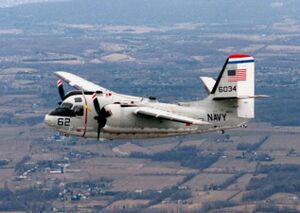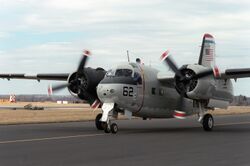Engineering:Grumman C-1 Trader
| C-1 (TF) Trader | |
|---|---|

| |
| A C-1A Trader from Naval Air Station, Willow Grove, Pennsylvania in 1987 | |
| Role | Carrier onboard delivery |
| National origin | United States |
| Manufacturer | Grumman |
| First flight | 19 January 1955 |
| Introduction | 1956 |
| Retired | 1988 |
| Primary user | United States Navy |
| Number built | 87 |
| Developed from | Grumman S-2 Tracker |
| Developed into | Grumman E-1 Tracer |
The Grumman C-1 Trader (TF prior to 1962) is a carrier onboard delivery (COD) variant of the Grumman S-2 Tracker. It was replaced by a similar version of the Northrop Grumman E-2 Hawkeye, the Grumman C-2 Greyhound.
Design and development
The C-1 Trader grew out of a need by the United States Navy for a new anti-submarine airplane. In response to this Grumman began development on a prototype twin-engine, high-wing aircraft which it designated the G-89. In 1952 the Navy designated this aircraft the XS2F-1 and flew it for the first time on December 4 that year. During the rest of the 1950s three major variants emerged, the C-1 Trader being one of them. The C-1 (originally the TF-1, for "Trainer", a secondary role)[1] was outfitted to carry nine passengers or 3,500 pounds (1,600 kg) of cargo and first flew in January 1955.
Operational history
Throughout the 1960s and 1970s the C-1 Trader carried mail and supplies to aircraft carriers on station in the Pacific Ocean during the Vietnam War and also served as a trainer for all-weather carrier operations. Over its production life 87 C-1 Traders were built, of which four were converted into EC-1A Tracer electronic countermeasures aircraft.[2] The last C-1 was retired from USN service in 1988; it was the second-to-last radial-engine aircraft in U.S. military service (The last C-131 wasn't retired until 1990). As of 2010, approximately ten were still airworthy in civil hands, operating as warbirds.[citation needed]
In 1956 the U.S. Marine Corps Test Unit Number 1 (MCTU #1) tested the concept of using the TF-1 variant as a vehicle for inserting reconnaissance teams behind enemy lines. “On 9 July 1956 MCTU Recon Marines became the first to parachute from a TF-1. Less than three weeks later, four recon parachutists launched from the USS Bennington, which was 70 miles at sea, and jumped on a desert drop zone near El Centro California, some 100 miles inland. For the first time in Marine Corps and Naval Aviation history, the technique of introducing recon personnel off a carrier sea base to an inland objective had successfully been tested.”[3]
In August 2010, Brazilian Naval Aviation announced that it would buy and modernize eight C-1 airframes to serve in carrier onboard delivery (COD) and aerial refueling roles for use on its aircraft carrier São Paulo.[4] In 2011 contract was signed with Marsh Aviation to convert four ex-US Navy C-1A Trader airframes into KC-2 Turbo Traders.[5] The first KC-2 prototype flight was expected for November 2017 and the delivery of the first operational aircraft was scheduled for December 2018.[citation needed]
Variants
- TF-1
- Carrier Onboard Delivery version of the S-2 Tracker with enlarged fuselage for nine passengers, redesignated C-1A in 1962, 87 built.
- TF-1Q
- Electronic Countermeasures conversion of the TF-1, redesignated EC-1A in 1962, four conversions.
- TF-1W
- Airborne Early Warning project that was developed in the WF-2 Tracer.
- C-1A
- TF-1 redesignated in 1962.
- EC-1A
- TF-1Q redesignated in 1962.
- KC-2 Turbo Trader
- Marsh Aviation modernization project for Air-to-Air Refueling, requested for the Brazilian Navy.[6]
- G-101
- proposed 10-12 seat passenger variant
- G-104
- proposed tanker variant
Operators
 United States
United States
- United States Navy
 Brazil (Retired)
Brazil (Retired)
- Brazilian Naval Aviation
Surviving aircraft
- Airworthy
- BuNo 136752 - based at Lauridsen Aviation Museum in Buckeye, Arizona.[7][8]
- BuNo 136766 - privately owned in Carson City, Nevada.[9]
- BuNo 136773 - privately owned in Wilmington, Delaware.[10]
- BuNo 136778 - based at Champaign Aviation Museum in Urbana, Ohio.[11][12]
- BuNo 136781 - based at Pacific Coast Air Museum in Santa Rosa, California.[13][14]
- BuNo 146027 - privately owned in Wilmington, Delaware.[15]
- BuNo 146044 - privately owned in Oklahoma City, OK.[16]
- BuNo 146048 - privately owned in Reno, Nevada.[17]
- BuNo 146052 - based at Lone Star Flight Museum in Galveston, Texas.[18]
- On display
- BuNo 136754 - National Museum of Naval Aviation, NAS Pensacola, Pensacola, Florida.[19]
- BuNo 136790 - Grissom Air Museum, Grissom ARB (former Grissom AFB), Kokomo, Indiana.[20]
- BuNo 136792 - NAVSUP Weapon Systems Support Philadelphia, Pennsylvania.[21] (formerly display at the Quonset Air Museum)
- BuNo 146034 - Wings of Freedom Aviation Museum, former NAS Willow Grove, Horsham, Pennsylvania.[22]
- BuNo 146036 - USS Midway Museum, San Diego, California.[23]
Specifications (C-1A)
Data from Grumman aircraft since 1929.[24]
General characteristics
- Crew: 1
- Capacity: 9 pax / 8,500 lb (3,856 kg) payload
- Length: 42 ft (13 m)
- Wingspan: 69 ft 8 in (21.23 m)
- Height: 16 ft 3.5 in (4.966 m)
- Wing area: 485 sq ft (45.1 m2)
- Airfoil: root: NACA 63A420; tip: NACA 63A415[25]
- Empty weight: 16,631 lb (7,544 kg)
- Gross weight: 23,031 lb (10,447 kg)
- Max takeoff weight: 24,600 lb (11,158 kg)
- Powerplant: 2 × Wright R-1820-82WA Cyclone 9-cylinder air-cooled radial piston engines, 1,525 hp (1,137 kW) each
- Propellers: 3-bladed constant-speed fully-feathering reversible-pitch propellers
Performance
- Maximum speed: 280 mph (450 km/h, 240 kn) at 4,000 ft (1,219 m)
- Cruise speed: 167 mph (269 km/h, 145 kn)
- Range: 1,110 mi (1,790 km, 960 nmi)
- Service ceiling: 24,800 ft (7,600 m)
- Rate of climb: 1,950 ft/min (9.9 m/s)
- Wing loading: 47.5 lb/sq ft (232 kg/m2)
- Power/mass: 0.1315 hp/lb (0.2162 kW/kg)
See also
- Carrier onboard delivery
Related development
Aircraft of comparable role, configuration and era
References
- ↑ Bishop, Chris; Chant, Chris (2004). Aircraft Carriers. London: Summertime Publishing Ltd.. pp. 168. ISBN 0-7603-2005-5.
- ↑ Donald, David; Daniel J. March (2001). Carrier Aviation Air Power Directory. Norwalk, CT: AIRtime Publishing. ISBN 1-880588-43-9.
- ↑ Lanning and Stubbe, Michael, Ray (1989). Inside Force Recon. Ivy Books. p. 34. ISBN -08041-0301-1.
- ↑ "Brazilian navy buys Traders". http://www.flightglobal.com/articles/2010/08/23/346412/brazilian-navy-buys-traders.html.
- ↑ "Brazilian Navy restarts KC-2 Turbo Trader contract". https://www.flightglobal.com/news/articles/brazilian-navy-restarts-kc-2-turbo-trader-contract-406169/.
- ↑ "Brazilian Traders set for modernisation" Fight Global, 14 Dec 2011 Retrieved: 23 December 2011
- ↑ "Grumman C-1 Trader/136752." Lauridsen Aviation Museum. Retrieved: 6 August 2021.
- ↑ "FAA Registry/N71456." faa.gov Retrieved: 6 August 2021.
- ↑ "FAA Registry/N6193Z." faa.gov Retrieved: 6 August 2021.
- ↑ "FAA Registry/N6193N." faa.gov Retrieved: 6 August 2021.
- ↑ "Grumman C-1 Trader/136778." Champaign Aviation Museum. Retrieved: 6 August 2021.
- ↑ "FAA Registry/N778SR." faa.gov Retrieved: 6 August 2021.
- ↑ "Grumman C-1A Trader/136781." Pacific Coast Air Museum. Retrieved: 6 August 2021.
- ↑ "FAA Registry/N475AM." faa.gov Retrieved: 6 August 2021.
- ↑ "FAA Registry/N927BN." faa.gov Retrieved: 6 August 2021.
- ↑ "FAA Registry/N189G." faa.gov Retrieved: 3 January 2023.
- ↑ "FAA Registry/N7171M." faa.gov Retrieved: 6 August 2021.
- ↑ "FAA Registry/N81193." faa.gov Retrieved: 6 August 2021.
- ↑ "Grumman C-1A Trader/136754." National Naval Aviation Museum. Retrieved: 27 April 2016.
- ↑ "Grumman C-1A Trader/136790." Grissom Air Museum. Retrieved: 27 April 2016.
- ↑ "USA Museum or Outside Display TF-1 /C-1A Traders". https://www.grummantracker.com/usatraders.htm. Retrieved 3 August 2023.
- ↑ "Grumman C-1A Trader/146034." Wings of Freedom Museum. Retrieved: 27 April 2016.
- ↑ "Grumman C-1A Trader/146036." USS Midway Museum. Retrieved: 27 April 2016.
- ↑ Francillon, René Jacquet (1989). Grumman aircraft since 1929 (1st ed.). London: Putnam. pp. 387–393. ISBN 0851778356.
- ↑ Lednicer, David. "The Incomplete Guide to Airfoil Usage". https://m-selig.ae.illinois.edu/ads/aircraft.html.
External links
 |



